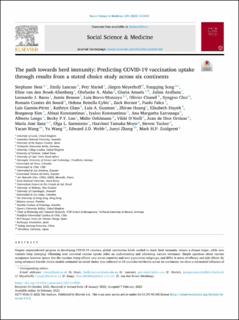| dc.contributor.author | Hess, Stephane | |
| dc.contributor.author | Lancsar, Emily | |
| dc.contributor.author | Mariel, Petr | |
| dc.contributor.author | Meyerhoff, Jürgen | |
| dc.contributor.author | Song, Fangqing | |
| dc.contributor.author | van den Broek-Altenburg, Eline | |
| dc.contributor.author | Alaba, Olufunke A. | |
| dc.contributor.author | Amaris, Gloria | |
| dc.contributor.author | Arellana, Julián | |
| dc.contributor.author | Basso, Leonardo J. | |
| dc.contributor.author | Benson, Jamie | |
| dc.contributor.author | Bravo-Moncayo, Luis | |
| dc.contributor.author | Chanel, Olivier | |
| dc.contributor.author | Choi, Syngjoo | |
| dc.contributor.author | Crastes dit Sourd, Romain | |
| dc.contributor.author | Cybis, Helena Bettella | |
| dc.contributor.author | Dorner, Zack | |
| dc.contributor.author | Falco, Paolo | |
| dc.contributor.author | Garzón-Pérez, Luis | |
| dc.contributor.author | Glass, Kathryn | |
| dc.contributor.author | Guzman, Luis A. | |
| dc.contributor.author | Huang, Zhiran | |
| dc.contributor.author | Huynh, Elisabeth | |
| dc.contributor.author | Kim, Bongseop | |
| dc.contributor.author | Konstantinus, Abisai | |
| dc.contributor.author | Konstantinus, Iyaloo | |
| dc.contributor.author | Larranaga, Ana Margarita | |
| dc.contributor.author | Longo, Alberto | |
| dc.contributor.author | Loo, Becky P.Y. | |
| dc.contributor.author | Oehlmann, Malte | |
| dc.contributor.author | O'Neill, Vikki | |
| dc.contributor.author | de Dios Ortúzar, Juan | |
| dc.contributor.author | Sanz, María José | |
| dc.contributor.author | Sarmiento, Olga L. | |
| dc.contributor.author | Moyo, Hazvinei Tamuka | |
| dc.contributor.author | Tucker, Steven | |
| dc.contributor.author | Wang, Yacan | |
| dc.contributor.author | Wang, Yu | |
| dc.contributor.author | Webb, Edward J.D. | |
| dc.contributor.author | Zhang, Junyi | |
| dc.contributor.author | Zuidgeest, Mark H.P. | |
| dc.date.accessioned | 2023-04-12T08:39:43Z | |
| dc.date.available | 2023-04-12T08:39:43Z | |
| dc.date.created | 2022-05-04T08:38:06Z | |
| dc.date.issued | 2022 | |
| dc.identifier.citation | Social Science and Medicine. 2022, 298 . | en_US |
| dc.identifier.issn | 0277-9536 | |
| dc.identifier.uri | https://hdl.handle.net/11250/3062545 | |
| dc.description.abstract | Despite unprecedented progress in developing COVID-19 vaccines, global vaccination levels needed to reach herd immunity remain a distant target, while new variants keep emerging. Obtaining near universal vaccine uptake relies on understanding and addressing vaccine resistance. Simple questions about vaccine acceptance however ignore that the vaccines being offered vary across countries and even population subgroups, and differ in terms of efficacy and side effects. By using advanced discrete choice models estimated on stated choice data collected in 18 countries/territories across six continents, we show a substantial influence of vaccine characteristics. Uptake increases if more efficacious vaccines (95% vs 60%) are offered (mean across study areas = 3.9%, range of 0.6%–8.1%) or if vaccines offer at least 12 months of protection (mean across study areas = 2.4%, range of 0.2%–5.8%), while an increase in severe side effects (from 0.001% to 0.01%) leads to reduced uptake (mean = −1.3%, range of −0.2% to −3.9%). Additionally, a large share of individuals (mean = 55.2%, range of 28%–75.8%) would delay vaccination by 3 months to obtain a more efficacious (95% vs 60%) vaccine, where this increases further if the low efficacy vaccine has a higher risk (0.01% instead of 0.001%) of severe side effects (mean = 65.9%, range of 41.4%–86.5%). Our work highlights that careful consideration of which vaccines to offer can be beneficial. In support of this, we provide an interactive tool to predict uptake in a country as a function of the vaccines being deployed, and also depending on the levels of infectiousness and severity of circulating variants of COVID-19. | en_US |
| dc.language.iso | eng | en_US |
| dc.publisher | Elsevier | en_US |
| dc.rights | Attribution-NonCommercial-NoDerivatives 4.0 Internasjonal | * |
| dc.rights.uri | http://creativecommons.org/licenses/by-nc-nd/4.0/deed.no | * |
| dc.title | The path towards herd immunity: Predicting COVID-19 vaccination uptake through results from a stated choice study across six continents | en_US |
| dc.title.alternative | The path towards herd immunity: Predicting COVID-19 vaccination uptake through results from a stated choice study across six continents | en_US |
| dc.type | Peer reviewed | en_US |
| dc.type | Journal article | en_US |
| dc.description.version | publishedVersion | en_US |
| dc.source.pagenumber | 16 | en_US |
| dc.source.volume | 298 | en_US |
| dc.source.journal | Social Science and Medicine | en_US |
| dc.identifier.doi | 10.1016/j.socscimed.2022.114800 | |
| dc.identifier.cristin | 2021229 | |
| cristin.ispublished | true | |
| cristin.fulltext | original | |
| cristin.qualitycode | 2 | |

